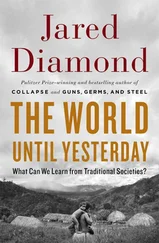Jared Diamond - Guns, Germs & Steel
Здесь есть возможность читать онлайн «Jared Diamond - Guns, Germs & Steel» весь текст электронной книги совершенно бесплатно (целиком полную версию без сокращений). В некоторых случаях можно слушать аудио, скачать через торрент в формате fb2 и присутствует краткое содержание. Жанр: 105. Описание произведения, (предисловие) а так же отзывы посетителей доступны на портале библиотеки ЛибКат.
- Название:Guns, Germs & Steel
- Автор:
- Жанр:
- Год:неизвестен
- ISBN:нет данных
- Рейтинг книги:5 / 5. Голосов: 1
-
Избранное:Добавить в избранное
- Отзывы:
-
Ваша оценка:
- 100
- 1
- 2
- 3
- 4
- 5
Guns, Germs & Steel: краткое содержание, описание и аннотация
Предлагаем к чтению аннотацию, описание, краткое содержание или предисловие (зависит от того, что написал сам автор книги «Guns, Germs & Steel»). Если вы не нашли необходимую информацию о книге — напишите в комментариях, мы постараемся отыскать её.
Guns, Germs & Steel — читать онлайн бесплатно полную книгу (весь текст) целиком
Ниже представлен текст книги, разбитый по страницам. Система сохранения места последней прочитанной страницы, позволяет с удобством читать онлайн бесплатно книгу «Guns, Germs & Steel», без необходимости каждый раз заново искать на чём Вы остановились. Поставьте закладку, и сможете в любой момент перейти на страницу, на которой закончили чтение.
Интервал:
Закладка:
154 * GUNS, GERMS, AND STEEL
species suitable for domestication. In fact, most areas where indigenous food production arose late or not at all offered exceptionally poor rather than rich resources to hunter-gatherers, because most large mammals of Australia and the Americas (but not of Eurasia and Africa) had become extinct toward the end of the Ice Ages. Food production would have faced even less competition from hunting-gathering in these areas than it did in the Fertile Crescent. Hence these local failures or limitations of food production cannot be attributed to competition from bountiful hunting opportunities.
lest these conclusions be misinterpreted, we should end this chapter with caveats against exaggerating two points: peoples' readiness to accept better crops and livestock, and the constraints imposed by locally available wild plants and animals. Neither that readiness nor those constraints are absolute.
We've already discussed many examples of local peoples' adopting more-productive crops domesticated elsewhere. Our broad conclusion is that people can recognize useful plants, would therefore have probably recognized better local ones suitable for domestication if any had existed, and aren't barred from doing so by cultural conservatism or taboos. But a big qualifier must be added to this sentence: "in the long run and over large areas." Anyone knowledgeable about human societies can cite innumerable examples of societies that refused crops, livestock, and other innovations that would have been productive.
Naturally, I don't subscribe to the obvious fallacy that every society promptly adopts every innovation that would be useful for it. The fact is that, over entire continents and other large areas containing hundreds of competing societies, some societies will be more open to innovation, and some will be more resistant. The ones that do adopt new crops, livestock, or technology may thereby be enabled to nourish themselves better and to outbreed, displace, conquer, or kill off societies resisting innovation. That's an important phenomenon whose manifestations extend far beyond the adoption of new crops, and to which we shall return in Chapter 13.
Our other caveat concerns the limits that locally available wild species set on the rise of food production. I'm not saying that food production could never, in any amount of time, have arisen in all those areas where it actually had not arisen indigenously by modern times. Europeans today
APPLES OR INDIANS • 155
who note that Aboriginal Australians entered the modern world as Stone Age hunter-gatherers often assume that the Aborigines would have gone on that way forever.
To appreciate the fallacy, consider a visitor from Outer Space who dropped in on Earth in the year 3000 b.c. The spaceling would have observed no food production in the eastern United States, because food production did not begin there until around 2500 b.c. Had the visitor of 3000 b.c. drawn the conclusion that limitations posed by the wild plants and animals of the eastern United States foreclosed food production there forever, events of the subsequent millennium would have proved the visitor wrong. Even a visitor to the Fertile Crescent in 9500 b.c. rather than in 8500 b.c. could have been misled into supposing the Fertile Crescent permanently unsuitable for food production.
That is, my thesis is not that California, Australia, western Europe, and all the other areas without indigenous food production were devoid of domesticable species and would have continued to be occupied just by hunter-gatherers indefinitely if foreign domesticates or peoples had not arrived. Instead, I note that regions differed greatly in their available pool of domesticable species, that they varied correspondingly in the date when local food production arose, and that food production had not yet arisen independently in some fertile regions as of modern times.
Australia, supposedly the most "backward" continent, illustrates this point well. In southeastern Australia, the well-watered part of the continent most suitable for food production, Aboriginal societies in recent millennia appear to have been evolving on a trajectory that would eventually have led to indigenous food production. They had already built winter villages. They had begun to manage their environment intensively for fish production by building fish traps, nets, and even long canals. Had Europeans not colonized Australia in 1788 and aborted that independent trajectory, Aboriginal Australians might within a few thousand years have become food producers, tending ponds of domesticated fish and growing domesticated Australian yams and small-seeded grasses.
In that light, we can now answer the question implicit in the title of this chapter. I asked whether the reason for the failure of North American Indians to domesticate North American apples lay with the Indians or with the apples.
I'm not thereby implying that apples could never have been domesticated m North America. Recall that apples were historically among the
156 • GUNS, GERMS, AND STEEL
most difficult fruit trees to cultivate and among the last major ones to be domesticated in Eurasia, because their propagation requires the difficult technique of grafting. There is no evidence for large-scale cultivation of apples even in the Fertile Crescent and in Europe until classical Greek times, 8,000 years after the rise of Eurasian food production began. If Native Americans had proceeded at the same rate in inventing or acquiring grafting techniques, they too would eventually have domesticated apples—• around the year a.d. 5500, some 8,000 years after the rise of domestication in North America around 2500 b.c.
Thus, the reason for the failure of Native Americans to domesticate North American apples by the time Europeans arrived lay neither with the people nor with the apples. As far as biological prerequisites for apple domestication were concerned, North American Indian farmers were like Eurasian farmers, and North American wild apples were like Eurasian wild apples. Indeed, some of the supermarket apple varieties now being munched by readers of this chapter have been developed recently by crossing Eurasian apples with wild North American apples. Instead, the reason Native Americans did not domesticate apples lay with the entire suite of wild plant and animal species available to Native Americans. That suite's modest potential for domestication was responsible for the late start of food production in North America.
CHAPTER 9
zebras, unhappy
marriages, and the
anna karenina
principle
DOMESTICABLE ANIMALS ARE ALL ALIKE; EVERY UNDO-mesticable animal is undomesticable in its own way. If you think you've already read something like that before, you're right. Just make a few changes, and you have the famous first sentence of Tolstoy's great novel Anna Karenina: "Happy families are all alike; every unhappy family is unhappy in its own way." By that sentence, Tolstoy meant that, in order to be happy, a marriage must succeed in many different respects: sexual attraction, agreement about money, child discipline, religion, in-laws, and other vital issues. Failure in any one of those essential respects can doom a marriage even if it has all the other ingredients needed for happiness.
This principle can be extended to understanding much else about life besides marriage. We tend to seek easy, single-factor explanations of success. For most important things, though, success actually requires avoiding many separate possible causes of failure. The Anna Karenina principle explains a feature of animal domestication that had heavy consequences tor human history—namely, that so many seemingly suitable big wild mammal species, such as zebras and peccaries, have never been domesticated and that the successful domesticates were almost exclusively Eurasian. Having in the preceding two chapters discussed why so many wild
Интервал:
Закладка:
Похожие книги на «Guns, Germs & Steel»
Представляем Вашему вниманию похожие книги на «Guns, Germs & Steel» списком для выбора. Мы отобрали схожую по названию и смыслу литературу в надежде предоставить читателям больше вариантов отыскать новые, интересные, ещё непрочитанные произведения.
Обсуждение, отзывы о книге «Guns, Germs & Steel» и просто собственные мнения читателей. Оставьте ваши комментарии, напишите, что Вы думаете о произведении, его смысле или главных героях. Укажите что конкретно понравилось, а что нет, и почему Вы так считаете.










